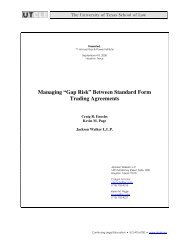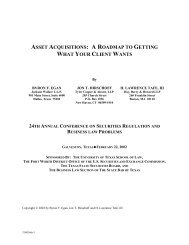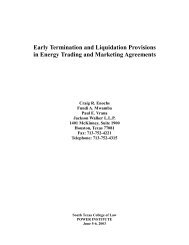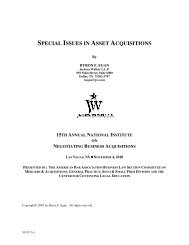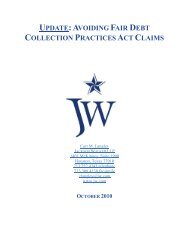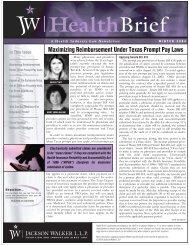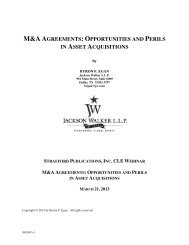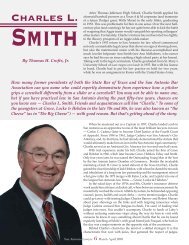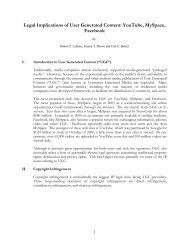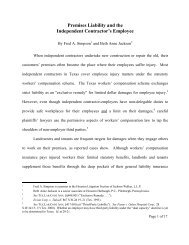busted m&a deals headed for litigation - Jackson Walker LLP
busted m&a deals headed for litigation - Jackson Walker LLP
busted m&a deals headed for litigation - Jackson Walker LLP
You also want an ePaper? Increase the reach of your titles
YUMPU automatically turns print PDFs into web optimized ePapers that Google loves.
may include some combination of cash, debt, and stock and may also have a contingent<br />
component based on future per<strong>for</strong>mance. For example, if a buyer does not have sufficient<br />
cash or wants to reduce its initial cash outlay, it could require that a portion of the purchase<br />
price be paid by a note. This method of payment, together with an escrow arrangement <strong>for</strong><br />
indemnification claims, is reflected in Section 2.3 of the Model Agreement. If the method of<br />
payment includes a debt component, issues such as security, subordination, and post-closing<br />
covenants will have to be resolved. Similarly, if the method of payment includes a stock<br />
component, issues such as valuation, negative covenants and registration rights must be<br />
addressed.<br />
If a buyer and a seller cannot agree on the value of the assets, they may make a<br />
portion of the purchase price contingent on the per<strong>for</strong>mance of the assets following the<br />
acquisition. The contingent portion of the purchase price (often called an “earnout”) is<br />
commonly based on the assets’ earnings over a specified period of time following the<br />
acquisition. Although an earnout may bridge a gap between the buyer’s and the seller’s view<br />
of the value of the assets, constructing an earnout raises many issues, including how earnings<br />
will be determined, the <strong>for</strong>mula <strong>for</strong> calculating the payment amount and how that amount<br />
will be paid (cash or stock), how the acquired businesses will be operated and who will have<br />
the authority to make major decisions, and the effect of a sale of the buyer during the earnout<br />
period. Resolving these issues may be more difficult than agreeing on a purchase price.<br />
The Model Agreement assumes that the parties have agreed upon a fixed price,<br />
subject only to an adjustment based on the difference between the Seller’s working capital on<br />
the date of the Balance Sheet and the date of Closing (see Sections 2.8 and 2.9).<br />
2.4 LIABILITIES<br />
(a) Assumed Liabilities. On the Closing Date, but effective as of the Effective Time,<br />
Buyer shall assume and agree to discharge only the following Liabilities of Seller (the<br />
“Assumed Liabilities”):<br />
(i) any trade account payable reflected on the Interim Balance Sheet (other than<br />
a trade account payable to any Shareholder or a Related Person of Seller) which<br />
remain unpaid at and are not delinquent as of the Effective Time;<br />
(ii) any trade account payable (other than a trade account payable to any<br />
Shareholder or a Related Person of Seller) that have been incurred by Seller in the<br />
Ordinary Course of Business between the date of the Interim Balance Sheet and the<br />
Closing Date which remains unpaid at and are not delinquent as of the Effective<br />
Time;<br />
(iii) any Liability to Seller’s customers incurred by Seller in the Ordinary Course<br />
of Business <strong>for</strong> non-delinquent orders outstanding as of the Effective Time reflected<br />
on Seller’s books (other than any Liability arising out of or relating to a Breach<br />
which occurred prior to the Effective Time);<br />
(iv) any Liability to Seller’s customers under written warranty agreements in the<br />
<strong>for</strong>ms disclosed in Part 2.4(a)(iv) given by Seller to its customers in the Ordinary<br />
4032470v.1<br />
- 47 -




